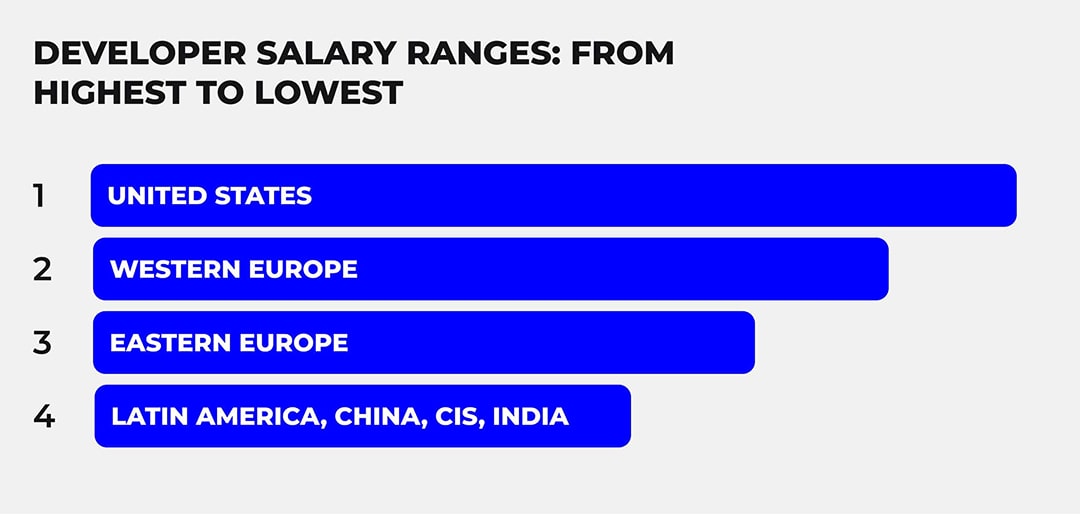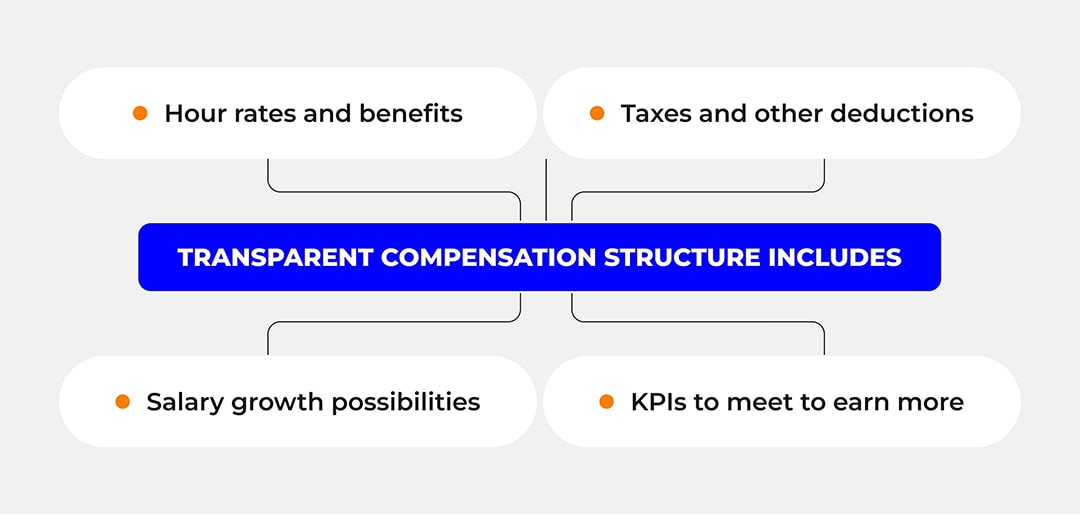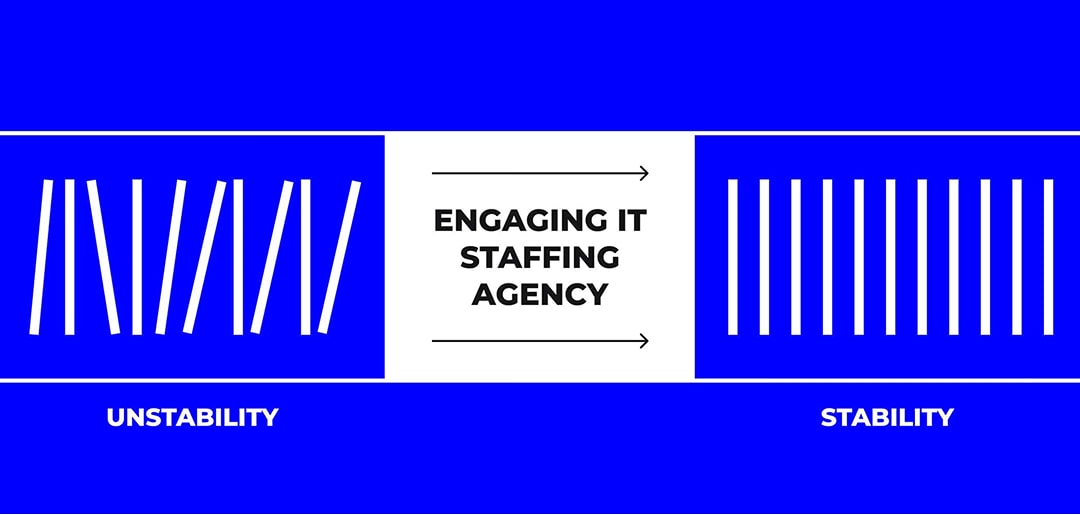Some truths are unbreakable: be it a global recession or an AI boom, it’s necessary to offer competitive compensations to attract good developers. That’s why when setting budgets for software development, almost every business owner asks Google about front-end and back-end developer salary. Yet to efficiently manage budget, it’s essential to know not only the numbers but the factors influencing them.
Want to see the full picture as tech recruiting services providers see it? Google no further, as I’ll review back-end vs. front-end developer salary and ways to hire at a better cost while with the same quality of hires.
Who Gets Paid More, Front-End or Back-End?
Back-end developers for hire get paid more if we compare back-end vs. front-end salary on average.
There is a perception that back-end development is more challenging and requires more expertise. Back-end developers can bring their specialized skills in server-side logic, databases, and security to the table. These skills are in high demand, and the complexity of their work often requires a deeper understanding of programming languages and system architecture.
Front-end development, while crucial for user experience, is sometimes undervalued despite the complexity involved in creating seamless and interactive interfaces. The duties of front-end developers may include translating design mockups into functional web pages and ensuring responsiveness of a website across various devices.
With a well-designed front end, the number of your app or website users grows, while a poorly designed front end can deter users from using a software even if your product has the best-in-class back-end. In this regard, it becomes clear that to hire Front-End Developer is not less important if you aim to increase your company revenue.
Instead of calculating who matters more to the project when deciding on front-end developer vs. back-end developer salary, I’d consider both devs as your keys to success.
Back-End vs. Front-End Developer Salary
The average salary of a Back-end Developer is $3,600-$6,000 higher than a Front-end developer’s salary if we are talking about a yearly salary within one company hiring those specialists for one project.
Within your team, you can minimize this front-end vs. back-end developer salary gap or establish equal compensation. Anyway, by knowing the current talent market trends, you cannot go wrong with salary ranges.
Ranges by Regions: Back-End Developer Salary vs. Front-end Developer Salary
The setting of a developer’s compensation starts with the exploring talent market in the chosen region. Tools like Glassdoor, Payscale, and industry reports can offer up-to-date data on compensation standards. An average salary by location would decrease from the West to the East in many cases, yet the LATAM region is an exception offering the US-based businesses low-cost solutions in the nearshore areas.

I suggest you look through how the compensations change globally. All the figures below refer to Senior specialists. For mid-level positions, it would be about 15% smaller values and for entry-level ones up to 40%.
United States
In the US, a front-end and back-end developer salary would be generally high, reflecting the advanced tech industry. According to recent data:
Front-end Developers earn up to $155,000 per year.
Back-end Developers earn up to $217,000 per year.
Europe
Compensations in Europe vary significantly depending on the country.
-
Western Europe (e.g., Germany, UK):
Front-end Developers: up to $92,000 per year;
Back-end Developers: up to $111,000 per year.
-
Eastern Europe (e.g., Poland, Hungary):
Front-end Developers: up to $60,000 per year;
Back-end Developers: up to $80,000 per year.
Latin America
Latin America is becoming an increasingly popular region for outsourcing due to competitive compensations and a growing pool of skilled developers.
-
Brazil
Front-end Developers: up to $67,000 per year
Back-end Developers: up to $75,000 per year
-
Mexico
Front-end Developers: up to $48,000 per year
Back-end Developers: up to $65,000 per year
-
Argentina
Front-end Developers: up to $55,000 per year
Back-end Developers: up to $67,000 per year.
CIS (Commonwealth of Independent States)
In CIS countries, salaries are generally lower compared to Western Europe and the US.
Front-end Developers: up to $45,000 per year
Back-end Developers: up to $72,000 per year
Asia
Asian countries exhibit a wide range of salaries.
-
India:
Front-end Developers: up to $25,000 per year
Back-end Developers: up to $42,000 per year
-
China:
Front-end Developers: up to $52,000 per year
Back-end Developers: up to $70,000 per year
As you can see, front-end vs. back-end developer salary fluctuates globally, yet the salary gap between both team roles remains the same.
Why Some Companies Face Difficulties When Setting Compensations for Devs?
They Don’t Do Market Research
We’ve mentioned the average figures for the USA, right? But if you zoom in, you can see the difference by cities:
New York Back-end Developer Salary: $147,214 per year
San Francisco Back-end Developer Salary: $165,982 per year
Seattle Back-end Developer Salary: $154,200 per year
Even by comparing only 3 cities, it becomes clear that you need to check as many compensation ranges as there are cities in the world to build a budget-friendly remote tech team.
Moreover, I strongly recommend you analyze what are the reasons for those differences. Try to find out if it is the relatively low cost of living or the unavailability of the advanced expertise across a certain region?
Task us with talent market
research tailored to the team
roles you need to fill.

What else along with exploring the compensation benchmarks can help you with optimizing hiring budgets? I have several proven strategies to share with you.
Strategies to Optimize Front-End and Back-End Developer Salary
Comprehensive Tech Stack Analysis
A developer with a certain tech stack mastered will most likely expect a salary based on experience. So, I’d compare not Front-end developer vs. Back-end developer salary, but rather React Developer vs. SQL Developer salary, for instance. When a client reaches out to us with a tech team scaling request, the first thing we ask is what are the required development frameworks.
The highest-paying front-end developer skills in the US include proficiency in technologies like React, Angular, and Vue.js. The back-end skills which are in high demand are Python, Java, and Ruby. The recent review by Coursera highlights that Back-end Devs working with Robotics typically earn 56% more than average, and those dealing with machine learning algorithms 13% more.
Both Front-end and Back-end developers’ incomes vary by industry. Thus, looking for a pro with a background in Legal, Real Estate or FinTech, we take into account that they are 5-10% more “expensive” than their colleagues who’ve developed software for Education or Manufacturing.
Workload Estimation
Keep in mind the specific roles and responsibilities of both developers in your team to set more accurate compensation levels. If currently, a Back-end Dev’s scope of work needed is noticeably smaller than a Front-end Dev’s… Well, reflect this in their compensations. It would be fair.
Skill Development Programs
To balance the expertise levels across front-end and back-end roles, I’d consider:
Training programs and certifications;
Cross-functional collaboration between front-end and back-end developers, which leads to a better understanding of each other’s roles and contributions.
Thus, you can get more skills paying the same compensation, reduce the potential disparity in compensation, and have more areas where your team members can help each other forcing delivery.
Transparent Compensation Structure
It’s much easier to attract good specialists and increase a team’s performance and motivation if you have a fair compensation system where all the aspects of the cost accruals are explained.
This approach ensures that your Front-end developers as well as your Back-end developers understand the criteria for salary levels and can strive to meet those benchmarks.

Flexible Compensation Packages
Here are some benefits you can offer to make your compensation package attractive without solely relying on salary increases.
Health insurance, retirement plans, performance bonuses, and stock options
The longer the list, the better, you might think. The more personalized the list, the better. Time spent on exploring what bonuses each developer prefers always converts into reduced turnover rates.
Hiring Full-Stack Developers
There are cases when it’s reasonable to hire Full-stack Developers who can cope with front-end and back-end development. It’s not only about paying one compensation instead of two, but also about making more rational decisions towards project development.
When creating an MVP. Full-stack Devs can handle both coding and UI design, turning ideas into functional prototypes quickly and efficiently.
When just starting your Project, Complex or Bootstrapped doesn’t matter. Full-stack devs can design and implement the holistic project from start to finish.
When modernizing legacy systems, these developers can integrate new features seamlessly into the upgraded system.
When scaling your existing team’s expertise.
When providing redundancy in teams supporting business-critical systems.
When minimizing communication delays and misunderstandings between Front-end and Back-end Devs.
It looks like the Full-stack developer roadmap covers everything. Then, why people hire Back-end and Front-end experts separately?
Having separate front-end and back-end developers allows for greater scalability and flexibility. If one area requires more attention, the team can adjust by hiring additional specialists without affecting the other part of the application.
Very often, a team needs all 3 types of devs, yet hiring them starts from the most critical at the moment.
Partnering with IT Staffing Agencies
How you engage tech talent matters. Outsourced or in-house recruitment, which of them is more targeted to get the most out of your hires?

A good IT staffing agency is a company able to take over a wide range of your concerns: from who gets paid more, front-end or back-end, to which retention techniques work for each of your team members better.
Outstaff Your Team technical recruitment and staffing services were designed to let you hire globally and make hiring more cost-effective for businesses worldwide. Join our clients’ family if you want to have a smoothly running software development team.
FAQ
Is the higher cost of back-end developers justified by the value they bring?
Back-end developer salary is pretty high as it is offset by the benefits of having a robust and efficient web application that can handle high traffic, process large amounts of data, and provide a seamless user experience. Yet both back-end and front-end developers help businesses to increase ROI. Modern software users demand greater interfaces than a decade ago, and the amount of knowledge necessary to succeed in front-end development grows from year to year. A hassle-free back end wrapped into a modern and easy-to-use front end is an outcome any CEO or CTO should prioritize when setting compensations. In other words, don’t pay Back-end devs more only because of the position name. Explore the compensations of developers with the skills covering your business targets.
What strategies can we use to attract top talent in both front-end and back-end development?
To attract top talent in both front-end and back-end development, implement these strategies:
Talent Acquisition. Use targeted recruitment campaigns and leverage industry connections.
Work-Life Balance. Promote flexible working hours and remote work options.
Career Development. Provide opportunities for growth, training, and career advancement.
Company Culture. Create an inclusive, innovative, and collaborative work environment.
Challenging Projects. Engage developers with cutting-edge technologies and interesting projects.
Recognition and Rewards. Recognize and reward contributions and achievements.
Competitive Compensation. Offer attractive salaries, bonuses, and benefits.
These strategies can help in creating a desirable workplace for top developers.
How can we ensure we're offering fair compensation for both front-end and back-end developers?
To balance Back-end vs. Front-end salary within a company or team, HR specialists can implement a structured compensation plan that considers relevant factors like experience, skills, certifications, and market data.
Ann Kuss is the CEO at Outstaff Your Team. After 11 years of expertise in building remote tech teams for startup unicorns and global tech brands, Ann decided to lead a new venture aiming to reinvent the way international tech teams scale. Throughout her career, Ann hired specialists for countless tech positions from more than 17 countries on all major continents. Ann graduated from Kyiv-Mohyla business school, is an MIM Kyiv alumna, and regularly takes part in mentorship programs for junior tech talents. Ann actively promotes knowledge sharing and curates Outstaff Your Team blog strategy, preferring topics that solve practical needs of IT leaders. She believes that structuring business flows (including hiring) is a well-planned journey with predictable and successful outcome.



